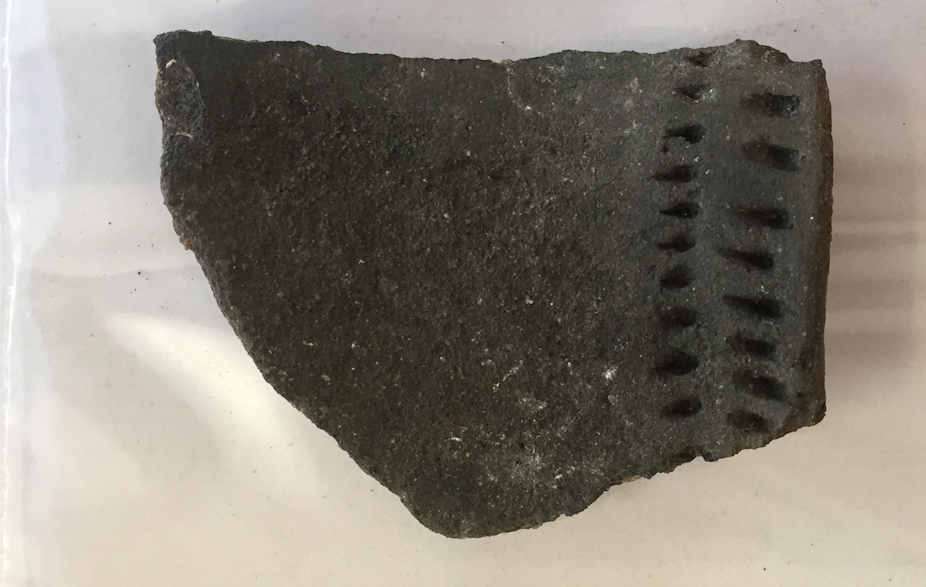The introduction of herding – a way of life which centres on keeping herds of mobile domesticated animals – significantly changed Africa’s genetic, economic, social and cultural landscapes during the last 10,000 years. Unlike other parts of the world, mobile herding spread throughout the continent thousands of years before farming and did not replace foraging in many places. This gave rise to complex mosaics of foragers and food producers across sub-Saharan Africa.
Once herding reached southern Africa during the early first millennium AD, it spread rapidly throughout the region, in part because of presumed local adoption of sheep by diverse groups of foragers. Since these foragers and herders left similar types of artefacts it is difficult to pinpoint who was herding in the archaeological record, their dietary choices, and how this way of life spread.
Traditional archaeological data alone – such as the types of animal bones present at sites – can’t always help. So, researchers need to combine multiple lines of evidence from both traditional and biomolecular archaeology, which involves studying ancient lipids (fats) and proteins.
I am an anthropological archaeologist whose research focuses on understanding how herders thrived in the Namaqualand coastal desert of South Africa over the last 2,000 years.
Recently I was part of a research team that wanted to better understand how ancient herders in Namaqualand incorporated sheep into their diet. We analysed the residues of past meals preserved in archaeological pottery. By analysing lipids entrapped in ancient pottery we found evidence for dairy fats.
This may seem, at first glance, to be merely historical curiosity with no current applications. But in reality, conducting this research now – while herding is still a viable economic activity in Namaqualand – can contribute to the broader discussion about climate resilient landscape use. Herding initially spread to Namaqualand amid environmental, economic and social change. Similar forces threaten the practice’s future. Understanding how ancient herders managed their herds in an unpredictable environment may offer insights for altering or refining current practices.
Studying the pots
Namaqualand, which covers around 50,000km², is located in the westernmost part of South Africa’s Northern Cape province.

It is bounded by the Atlantic Ocean to the west, the Kamiesberg Mountains about 100km to the east, the Oliphants River to the south and the Orange River to the north. This semi-arid desert has an average annual rainfall of 150mm; more than 66% of that falls in the winter months. The largest town in the region is Springbok, with a population of just under 13,000.
There generally aren’t many livestock bones present at archaeological sites in the region. This is because herders were highly mobile, with small herds, and didn’t regularly consume their sheep.
However, there is an archaeological resource that exists in abundance: pottery sherds. These contain microscopic traces of the ancient meals cooked in them. Analysing these pottery-bound lipids using a method called organic residue analysis allows researchers to identify ruminant (for example sheep, cow, antelope), non-ruminant (for example seal, shellfish, fish), and ruminant dairy fats that were cooked in the pots. Finding dairy fats in pottery provides evidence for livestock when their bones are absent or unidentifiable at archaeological sites.
Read more: Chemical traces in ancient West African pots show a diet rich in plants
We analysed pottery from four archaeological sites in the region dated to between AD 137 and AD 1643 to help unravel the dietary choices of ancient herders and foragers in Namaqualand.
The two inland sites located along the Orange River contained the remains of domesticated animals and pottery. The two coastal sites did not contain domesticate remains but did contain pottery, generally regarded as a proxy for herders.
We found that the people using these pots ate a variety of foodstuff including ruminant and non-ruminant animal fats. We also found the first direct evidence for people processing milk in South African pottery.
These findings suggest that low-intensity herders living in Namaqualand during the period we studied didn’t rely solely on their domesticated animals for all or even most of their daily dietary needs. Instead they had diverse diets and relied on a range of species for daily subsistence.
Looking ahead
Our next step is to characterise the ceramic-bound proteins preserved in the pottery. Organic residue analysis is a powerful tool. But it can only separate lipids into broad categories (dairy, ruminant, non-ruminant). Ceramic-bound proteins, meanwhile, are similar to DNA in that they encode fundamental genetic information that is key to identifying species. This species-level data is vital since early food producer sites consist of wild and domestic species that look similar.
Though this research focuses on the distant past, it has applications today, too.
Read more: Livestock are threatened by predators – but old-fashioned shepherding may be an effective solution
In Namaqualand, herding remains an important livelihood for many: 60% of households participate in some form of daily herding activity. Globally, many herders face serious water, food, and pasture scarcity. Herders in Namaqualand are being exposed to extreme temperatures and often have severely limited access to water and pasture.
So, this more targeted type of research on the resource use and subsistence decisions of archaeological herders who thrived in an unpredictable environment is important and timely.

